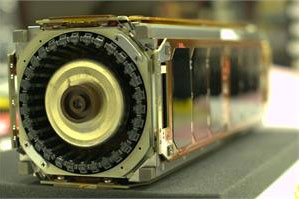
[SatNews] “You can’t fly something in space unless it’s flown in space.”..
USC’s Space Engineering Research Center (SERC) launched the first “CubeSat”—a miniature satellite built in cubic compartments—with the ability to deploy a parabolic dish and track a point on the surface of the Earth.
The satellite, dubbed “Aeneas,” is the first CubeSat with this tracking capability, which it will use in an attempt to track shipping containers on the open ocean. While satellites are generally operated pointed towards a fixed location (Earth, the sun, a star, etc.), Aeneas will employ three-axis stabilization control to track the moving containers, demonstrating that global satellite tracking can be performed by nanosatellites.
Part of a widespread effort to build nanosatellites at relatively low cost, CubeSats represent a cost-effective way to explore new satellite architectures and address niche applications, as they can easily piggyback onto other space launches. What used to require a $6 million spacecraft and a $20 million launch could theoretically be done for a fraction of the price, provided the mission is not too complex.
"This is yet another testament to the great nanosatellite work being done at USC Information Sciences Institute and the Viterbi School’s Astronautical Engineering Department,” said Yannis C. Yortsos, Dean of the USC Viterbi School of Engineering. “It continues a strong tradition of USC engineering involvement in space. We couldn't be more pleased to be part of the Aeneas mission."
Aeneas was launched on a United Launch Alliance Atlas V rocket from Vandenberg Air Force Base near Lompoc, California. Built at USC’s Information Sciences Institute (ISI) by a rotating team of students and staff members, Aeneas marks two firsts for cube satellites: It will be both the first CubeSat in history to ground track (or track a point on the surface of the earth) and the first to deploy a half-meter parabolic dish, the largest deployable from a nanosatellite. A system nearly three years in the making, the dish is a high gain antenna, to be deployed from a structure not much larger than a loaf of bread.
Aeneas’ main payload is a 1-watt WiFi-like transceiver that will be used to track the cargo containers and that will aid the Department of Homeland Security in its Secure Corridors program. A secondary payload that was designed and built but missed integration was a space qualification demonstration of the MAESTRO (the next generation of space computer) processor developed by Boeing and funded by the National Reconnaissance Office (NRO). A 49-core processor, the chip is being launched to test its capability of working in orbit. As SERC’s Associate Director Tim Barrett explains, “You can’t fly something in space unless it’s flown in space.” The MAESTRO processor is now scheduled to fly on an upcoming launch.

